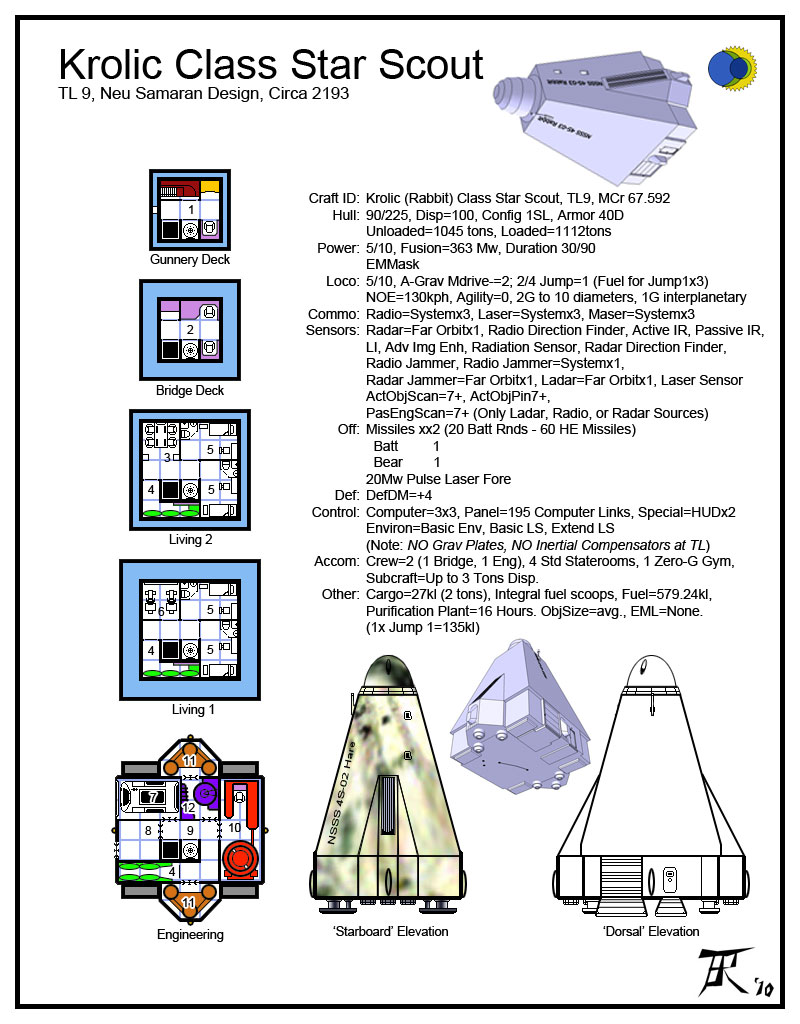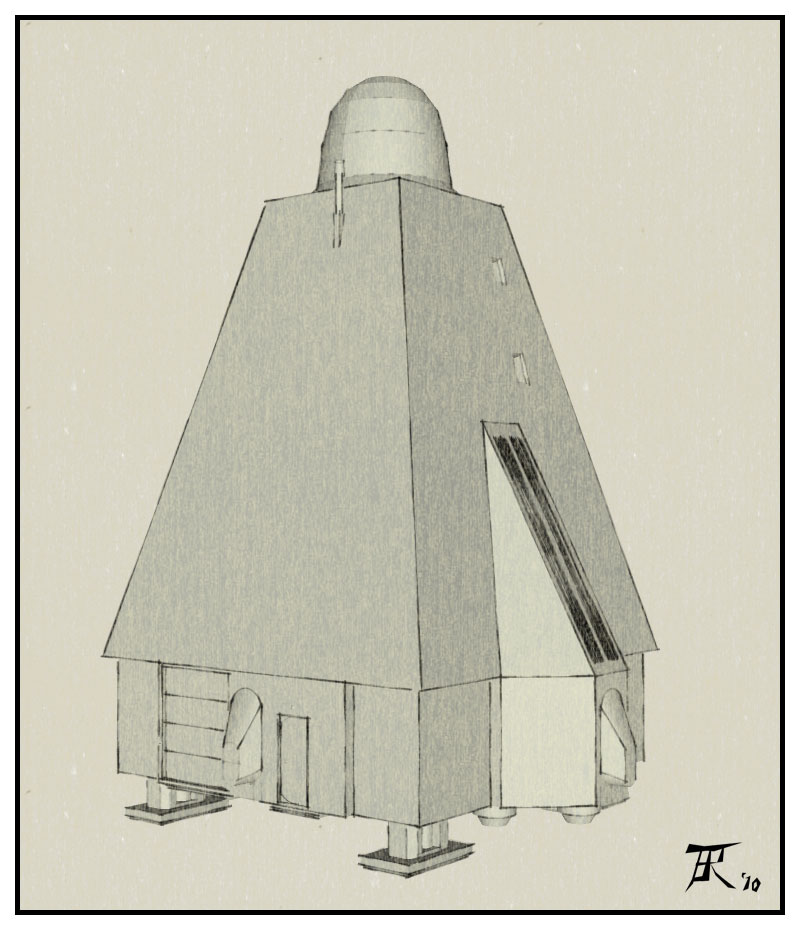Krolic-class Star Scout (TL 9)
This article originally appeared in Issue #011 of the downloadable PDF magazine.
Neu Samara’s first jump capable ship class, capable of 40 days constant operation and 3 consecutive Jump-1s in a row (1 week ea, per parsec). Because of the lack of sophistication of local Grav Plate and Inertial Compensator technologies, the Krolic (or Russian Rabbit) class scouts were all tail standers, with the decks stacked one on top of each other.
Though capable of 2G acceleration when within a gravity well, once the Krolic hits interplanetary space, its thrusters lose efficiency to only 1G constant acceleration—making the ship perfectly livable while in transit.
At turnaround points midway to the ship’s destination, and during the week long periods of jumpspace where acceleration isn’t possible, the crew has to adapt to a zero G environment until normal acceleration (or deceleration) can be reapplied. A small gymnasium is standard on the Krolic to help prevent loss of muscle and bone during these periods.
Though ‘state of the art’ for its era, the Krolic’s appearance led to it being given nicknames such as ‘The Gale House’ and ‘Witch Crusher’. The arrangement of the cargo room’s external door contributes to this appearance, and is not helped at all that the architect added a porch-light and a ‘doorbell’ style communicator next to the hatch.
 Deckplan Key
Deckplan Key
(click on the images to see them at full size. The deckplan image also includes the MegaTraveller stats)
- Gunner Deck. Access through the entire ship is available through side by side access hatches and elevators that end on this deck. Though the turret is overhead, control and magazine storage are located, along with the majority of the communications equipement, on this deck.
- Bridge Deck. A bit tiny, with a closet containing one of the spare ship’s computers. 2 control stations are installed, in case the ship has a double sized crew, with one favoring navigation and command functions, and the other favoring piloting.
- Common Area. The table folds away, and the chairs can be stowed or moved about to create a number of different arrangements, depending on crew preference, and zero-G necessities. A large entertainment monitor rests against the back wall, and zero-G bubble hydroponics often hang from the ceiling as decorative additions.
- Life Support. Storage areas containing the air filtration, recycling, water purification, ration storage, and and algae food supplement tanks.
- Staterooms. All the furniture is by default, clasped to the decking. Bathrooms are zero-G accommodation by default, even when working under gravity, so aren’t the most popular even by old hands in the Neu Samaran Space Service. Beds all have automatic webbing frames that double as emergency acceleration couches, as well as prevent Zero-G sleepers from floating about the cabins in their sleep.
-
 Zero-G Gym. Includes exercycles, resistance based exercise gear, and
a big screen flatscreen monitor for inspiration during workouts.
Zero-G Gym. Includes exercycles, resistance based exercise gear, and
a big screen flatscreen monitor for inspiration during workouts. - Vehicle Hanger. An extendable ramp leads down to ground level. Krolic-class Star Scouts were still used heavily when there weren’t that many reliable grav vehicles being made on planet, and so often would have ATVs custom built to fit their hangers.
- Cargo. Cargo, mission gear and extra provisions, were stored here. Unfortunately this was also the only primary access besides the vehicle hanger the crew had to the outside world when the ship was planetside. Often trash that wasn’t jettisoned into space for whatever reason would accumulate in this room, making it an embarrassing antechamber to lead ‘guests’ through into the rest of the ship. Most captains took great pains to keep the room tidy as possible, since often the first glance at human and minsk ‘technological superiority’ was through this ship’s ... cargo room.
- Access Corridor. Emergency gear is stored in the corners of the ceiling or in webbing along the walls in this room, giving the deck a ‘cramped and close’ feeling.
- Main Power. The ship’s fusion plant resided in this chamber, along with the second computer backup. In a pinch, the ship could be operated from this station.
- Maneuver Drive. Prior to thruster technology, ships like the Krolic had to use advanced contra-grav for acceleration not just off the planets themselves, but across interplanetary space. Though contra-grav still provided some thrust against the universe’s background gravitational forces, its efficiency would invariably be cut to half roughly past the 10 diameter limit of any significant gravitational body.
- Jump Drive. The Karposky Six may not live up to the Jump-2 performance of Terran and Vilani vessels far to coreward, but they were Neu Samara's first reliable jump drive, and gave the Krolic an operational lifespan well in excess of 60 years, long after other systems would have to be replaced or upgraded completely. Reliability was paramount with a ship that had to ‘rabbit jump’ consecutively so often to get where it was headed.
Ewan Quibell has provided High Guard (Classic Traveller Book 5) stats for this ship:
EX-1212231-000000-00002-0 MCr 63.394 100 Tons Bat Bear 1 Crew: 2 Bat 1 TL: 9 Cargo: 2 Fuel: 32 EP: 2 Agility: 1 Craft: 1 x 3T Fuel Treatment: Fuel Scoops and On Board Fuel Purification 1 ton Zero-G Gym Architects Fee: MCr 0.634 Cost in Quantity: MCr 50.715with 28 days duration and 3x Jump 1, and 4 staterooms
The Zero-G Gymnasium can be added to other ships as follows:
27kl/2tons disp, 4 tons mass, 0.015 MW, 0.2 MCr
 Freelance
Traveller
Freelance
Traveller